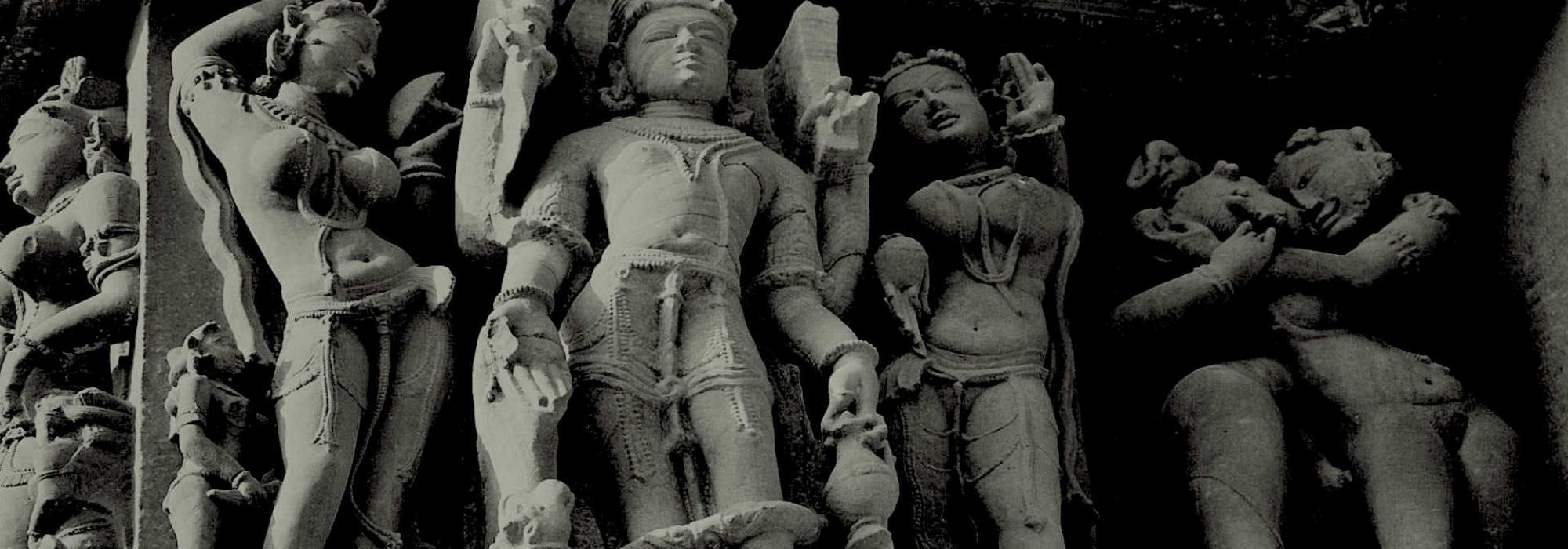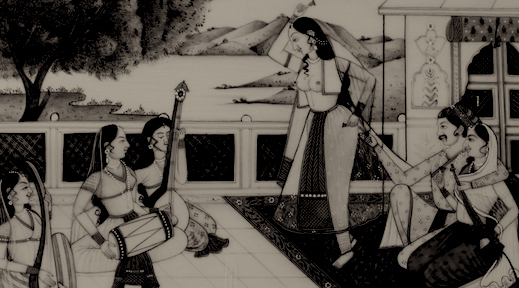With the kind of excesses of material opulence that the golden era of Krishnadevaraya offered to people inhabiting it—with lavish homes, variety of clothing, expansive gardens, and expensive perfumes, it is only natural that this array of sensual opulence also reflected itself in the enjoyment of that other timeless ingredient: pleasures of the amorous kind.
A Celebration of Amorousness
The poets of that era wrote with a special eye on the mindset of a connoisseur who waited in the bedroom with anticipation. It was an era that did not frown upon polygamy but rather celebrated it. The ability of a man to attract more than one woman was regarded as a hallmark of manliness. Peddanna and Timmanna held that Krishnadevaraya’s vanquishing of Adil Khan and his amorous conquest of women reflected the same masculinity. Once while camping at Srikakulam on the day of the Ekadashi (Eleventh Day of the Moon), Sri Krishnadevaraya had a dream in which Lord Sri Mahavishnu appeared before him. When he narrated this dream, his courtiers gave their verdict[i] as to what it meant: “You will obtain many beautiful women as lovers.”
But polygamy is not without problems. One couldn’t simply marry any lady without crossing the obstacles of varna, status, and other factors. Therefore, the men of that era—mostly rulers and chieftains—heralded a tradition of taking lovers. This reached such a fever pitch that they regarded as more pleasing to have even their most mundane tasks to be performed by pretty ladies than men. Thus, chieftains and rich businessmen had their head massaged by beautiful women; women had to bathe them, towel them, decorate them, and some even had women stand next to them, holding their sword.
But then, as in every era, there was a dearth of pretty girls to provide this sort of indulgence. Those pretty girls hailing from reputed families would naturally refuse to accept a place slightly better than a servant. Thus, courtesans were employed for the task. It is for this reason that the women employed for these tasks in the King’s harem as well as in that of businessmen were courtesans. Eventually, the influence of courtesans grew in society. Every temple had to have a music and dance recital by these women—it was an essential part of the Seva or offering to God. This tradition, also known variously as the Devadasi tradition, was carried on unbroken for centuries until the colonial British laws rudely severed it, leaving hundreds of Devadasis impoverished.
The question then arises as to whether this kind of ample supply of courtesans was available in the respective city or town. And so, to mitigate any shortfall, people like Avachi Tippayya Shetty,[ii] the Chief of the Royal Perfumery came handy. Also in charge of exports and imports, he would procure the prettiest of women from faraway lands together with gold, precious stones, jewelry, horses, and chariots.
It must be clarified that the word “courtesan” in this essay is used not in the contemporary sense of a woman merely selling her body for monetary gain. They were well-versed in and endowed with deep scholarship in classical arts in multiple languages. This apart, they were adept at playing the Veena; they were rigorously trained in classical vocal music; they could perform classical dance with equal felicity.
The charm and power they wielded over men was truly incredible. As an example one can cite the skill with which the connoisseurs of Krishnadevaraya’s time would mollify these women who were perchance displeased with them. If a woman kicked the head of a man with her left foot, instead of being furious, the man would gently whisper to her, “did that lovely foot get hurt?” Not for these sensualists the pointless act of severing all ties with her. Krishna, the Lord of Sixteen Thousand wives employed this pacifying technique upon an enraged Satyabhama who kicked his head with her left foot, as Timmanna shows in his Parijaataapaharana. The backstory to this is more interesting: this poem was Timmanna’s way of tutoring his king and patron, Krishnadevaraya on the fine art of mollifying his queen.
When we compare this seemingly extreme sensual indulgence of that time with our own present time, it appears that we are far better. Polygamy is all but dead today. We don’t pursue amorous pleasures with the same zeal. All this is appreciable indeed. But this is only the partial truth. The equal reason why we no longer zealously pursue fleshly pleasures owes both to inability and an incurable hangover of Victorian morality. Kama (used here in the sense of sexual desire), like Dharma, Artha and Moksha is also a value (Purushartha) in itself. And so, for that rare, blessed, courageous person who truthfully pursues the other three Purusharthas, the pursuit of Kama too, stands on an equally high pedestal, worthy of taking pride in, and not regarded as something to be ashamed of. This doesn’t mean an advocacy of a blind quest of hedonism. Nor does it mean this sort of pursuit is defect-free. But then which worldly pursuit is totally defect-free? Everything in the world becomes either a value or a defect depending on the ability and wisdom of the person. Indeed, the fear of whether even a virtuous act might result in harm and therefore abstaining from it is akin to forsaking food due to the fear of indigestion.
The Spirit of Krishnadevaraya’s Citizens
Then there’s the question of abstinence. Even here, are we endowed with the Sattva Guna, or the innate courage for it? People of our time need an external factor to enforce an unwilling abstinence—they are bereft of that warrior-like spirit to abstain on their own. This despicable weakness of spirit among Indian people has characterized pretty much the history of Independent India.
But the people of Krishnadevaraya’s time were adroit in both: when they no longer found any taste in worldly indulgences, they instantly discarded them and displayed that same vibrant connoisseurial spirit in the world of renunciation.
A fully decked up Maharaja Matsyadhwaja was on his way to a courtesan’s house one night as was his usual habit. En route was a Brahmana’s home. This Brahmana earlier in the day, had consumed copious amounts of a lavish spread at a feast. Sprawled on his verandah with some guests, he was reciting some poems to pass time. As he was passing by, Matsyadhwaja heard this poem:
वर्षार्थमष्टौ प्रयतेत मासान्
निशार्थमर्धम् दिवसे यतेत ।
वार्धक्यहेतोर्वयसा नवेन
परत्रहेतोरिह जन्मना च ॥
To savour this rainy season, we must suffer for the rest of the eight months|
Thus, for (resting at) night, in the day, thus for old age, in youth, and
Thus to attain the Other World (Heaven, Moksha etc) must we suffer in this world ||
That very instant, Matsyadhwaja lamented, “how I have been cheated,” gave up his royal splendor and all the pleasures it afforded him. He became a renunciate[iii] with a singular quest for attaining Moksha.
Our modern people argue that this sort of instant change is not natural, that it is contrived, and fictional. This sort of argument only exposes the selfsame poverty of Sattva Guna in our nature: what does a man whose hand is crippled know of the power and ability of a sword in the hands of a furious warrior?
[contextly_sidebar id="RwjlxXfGxcS1DCn3YLeWozYDu4d5TWkn"]
In essence, it must be said that people of Krishnadevaraya’s period were neither selfish hedonists nor were they only Yogis who had forsaken everything. The aforementioned instances of the pursuit of worldly pleasures and that of renunciation were mentioned only to give an idea of the immense willpower, determination, and unwavering strength to accomplish any endeavor they set their hearts and minds on. They fought wars; they won kingdoms; they ruled and protected; they carved sculpted works of art that we can’t even dream of; they encouraged and patronized learning and wisdom; they gave generous gifts without a thought.
In closing, it must be said that they attained the very summit of excellence in any endeavor they took up. This is the ultimate fruit of a connoisseurial life. Just like how their epicurean life was enormous so was their compassion, valour, generosity, scholarship and renunciation. There was no place for pettiness in any aspect of their lives. As the connoisseurial spirit grows among a people so does a spirit of expansiveness—both good and bad—grow.
Ultimately, a connoisseurial spirit is where civilization reposes; it is the fruit of vigour; it is both the foundation and the receptacle of progress.
Concluded
Notes:
[i] Itodhika bahu preyasiipraapti: Amuktamalyada
[ii] Mahakavi Srinatha dedicated his Haravilasa to Tippayyashetty who lived in the 15th Century as a subject of the Reddi chieftains.
[iii] Amuktamalyada














































